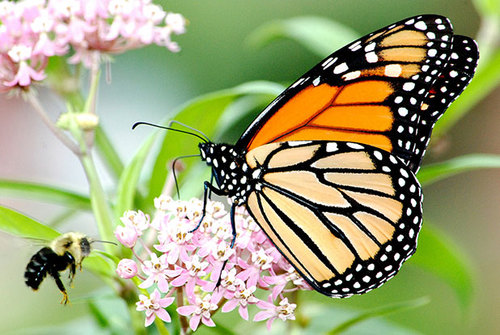
Monarch butterfly on swamp milkweed in Michigan. Photo by Jim Hudgins/USFWS.
On April 8, 2020 the U.S. Fish and Wildlife Service (Service) announced its next step in conservation of the Monarch butterfly (Danaus plexippus plexippus): finalization of the Nationwide Candidate Conservation Agreement for Monarch Butterfly on Energy and Transportation Lands (Monarch CCAA/CCA). The Monarch CCAA/CCA functions as both a candidate conservation agreement with assurances (CCAA) covering non-federal lands and a candidate conservation agreement (CCA) covering federal lands.
Authorized by Endangered Species Act (ESA) regulations, CCAAs are agreements between the Service and non-federal entities to implement actions on non-federal lands providing a net conservation benefit for species that are candidates for listing under the ESA or are likely to become candidates. Ultimately, where the Service approves a CCAA, the agency will issue an enhancement of survival permit (EOS Permit) under ESA section 10, which becomes effective upon a final listing. Similarly, CCAs are agreements between the Service and federal, tribal, state, local, and/or private entities to implement actions, including on federal lands, providing a net conservation benefit for candidate species or those likely to become candidates. Unlike a CCAA, however, the Service does not issue an EOS Permit in connection with a CCA. Implementation of CCAA/CCAs may preclude the need for listing.
Adoption of the Monarch CCAA/CCA ensures that if the species is ultimately listed, entities who have agreed to participate in the CCAA/CCA (Participants), have ownership or control of non-federal lands, and are carrying out the agreed-upon conservation measures receive incidental take authorization through the EOS Permit. Such Participants also receive regulatory assurances that different or more extensive conservation measures will not be required in the future. Pursuant to the terms of the Monarch CCAA/CCA, Participants undertaking activities on federal lands receive incidental take through the ESA section 7 consultation process associated with the Service’s issuance of the EOS Permit in connection with the CCAA.
The Monarch CCAA/CCA covers land managed by utilities and transportation agencies in monarch butterfly migration and breeding areas in the lower 48 states (excluding overwintering sites), and will be administered by the University of Illinois-Chicago. The terms require participating energy and transportation partners (also, Participants) to protect or create monarch butterfly habitat in their rights of way, such as by adjusting the timing of vegetation management to reduce impacts to monarchs, avoiding or modifying the use of herbicides to preserve food sources (milkweed and flowering plants), revegetation with local seed mixes that include a variety of flowering plants and milkweed, and adaptive management strategies. The Service has issued the EOS Permit to the University of Chicago and Participants, which will authorize incidental take of the monarch butterfly in covered areas, should it be listed in the future and should Participants continue implementing the required conservation measures.
The Monarch CCAA/CCA effort is the result of significant stakeholder collaboration to forestall the listing of the monarch. In 2014, a group of environmental non-governmental organizations petitioned the Service to list the monarch under the ESA, and the Service made a “positive 90-day finding,” on December 31, 2014. The Service was overdue in making the requisite 12-month finding, and groups sued over the Service’s failure to meet the deadline. The Service and challenging parties reached a settlement, and pursuant to subsequent extensions, the Service is due to make a 12-month finding in December 2020. The December 2020 finding will result in the Service proposing to list the species, concluding that listing is not warranted, or concluding that listing is warranted but precluded by higher priorities. The Service’s Policy for the Evaluation of Conservation Efforts (known as the “PECE” Policy) dictates how conservation efforts may factor into a listing decision. The finalization of and magnitude of participation in the Monarch CCAA/CCA will be a significant factor in the Service’s decision whether to list the monarch.
- Partner
Brooke Marcus is a natural resources lawyer focused on assisting the renewable energy sector with maintaining compliance with environmental laws. She is go-to counsel for matters involving the Endangered Species Act (ESA), the ...
- Partner
Rebecca Hays Barho focuses her practice on natural resource law, with particular emphasis on the Endangered Species Act (ESA), the National Environmental Policy Act (NEPA), the Migratory Bird Treaty Act (MBTA), the Clean Water Act ...
Nossaman’s Endangered Species Law & Policy blog focuses on news, events, and policies affecting endangered species issues in California and throughout the United States. Topics include listing and critical habitat decisions, conservation and recovery planning, inter-agency consultation, and related developments in law, policy, and science. We also inform readers about regulatory and legislative developments, as well as key court decisions.
Stay Connected
 RSS Feed
RSS Feed
Categories
- Alternative Energy
- Bald and Golden Eagle Protection Act
- Budget
- CEQA
- CESA
- Climate Change
- Congress
- Conservation
- Construction Projects
- Consultation
- Continuing Education
- Court Decisions
- Critical Habitat
- Delisting
- Endangered Species Act
- Event
- Fish & Wildlife Service
- Freedom of Information Act
- Government Administration
- Legal
- Legislation
- Listing
- Litigation
- Migratory Bird
- National Marine Fisheries Service
- NEPA
- Off Shore Wind
- Pacific Northwest
- project
- Publications
- Regulatory Reform
- Sacramento-San Joaquin Delta
- SEPA
- Speaking Engagements
- Supreme Court
- Texas
- Timberland
- Water Issues


